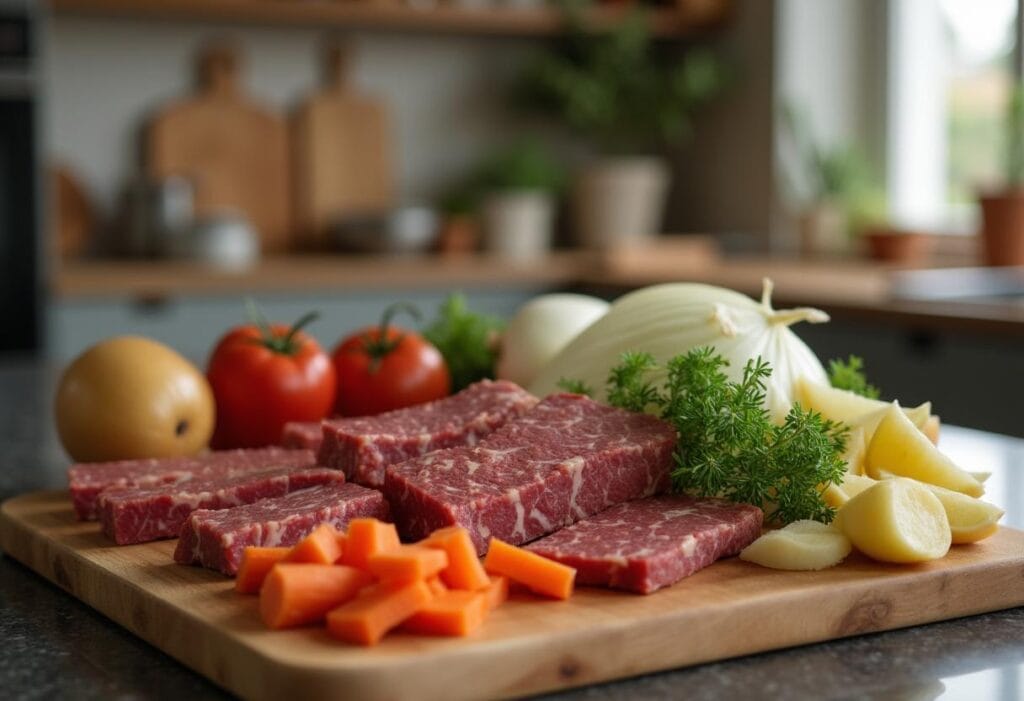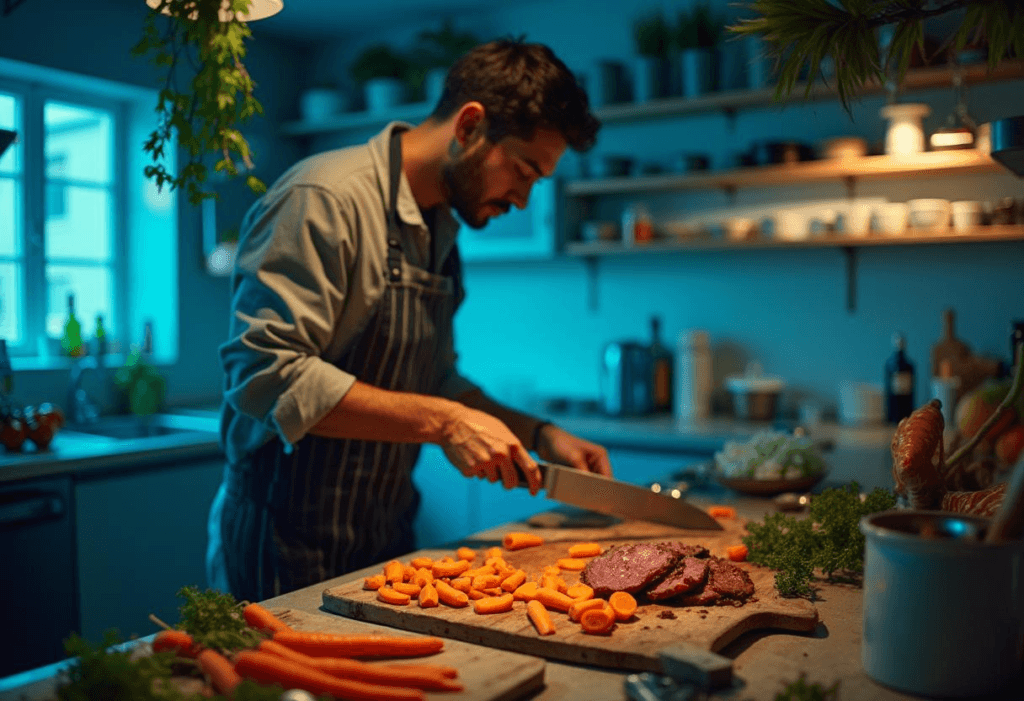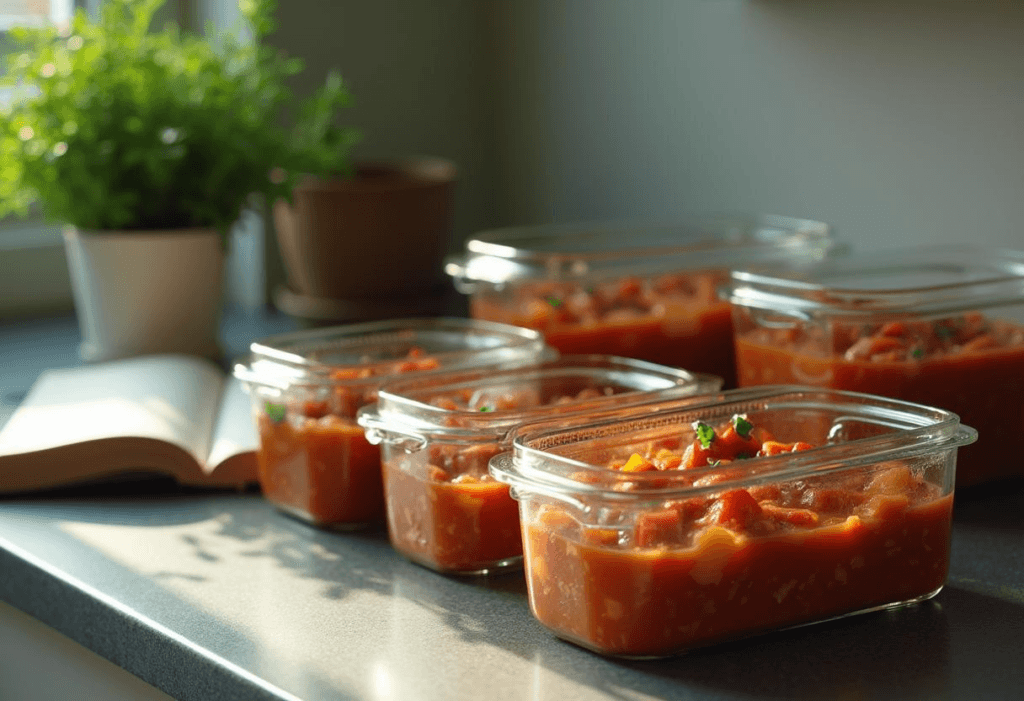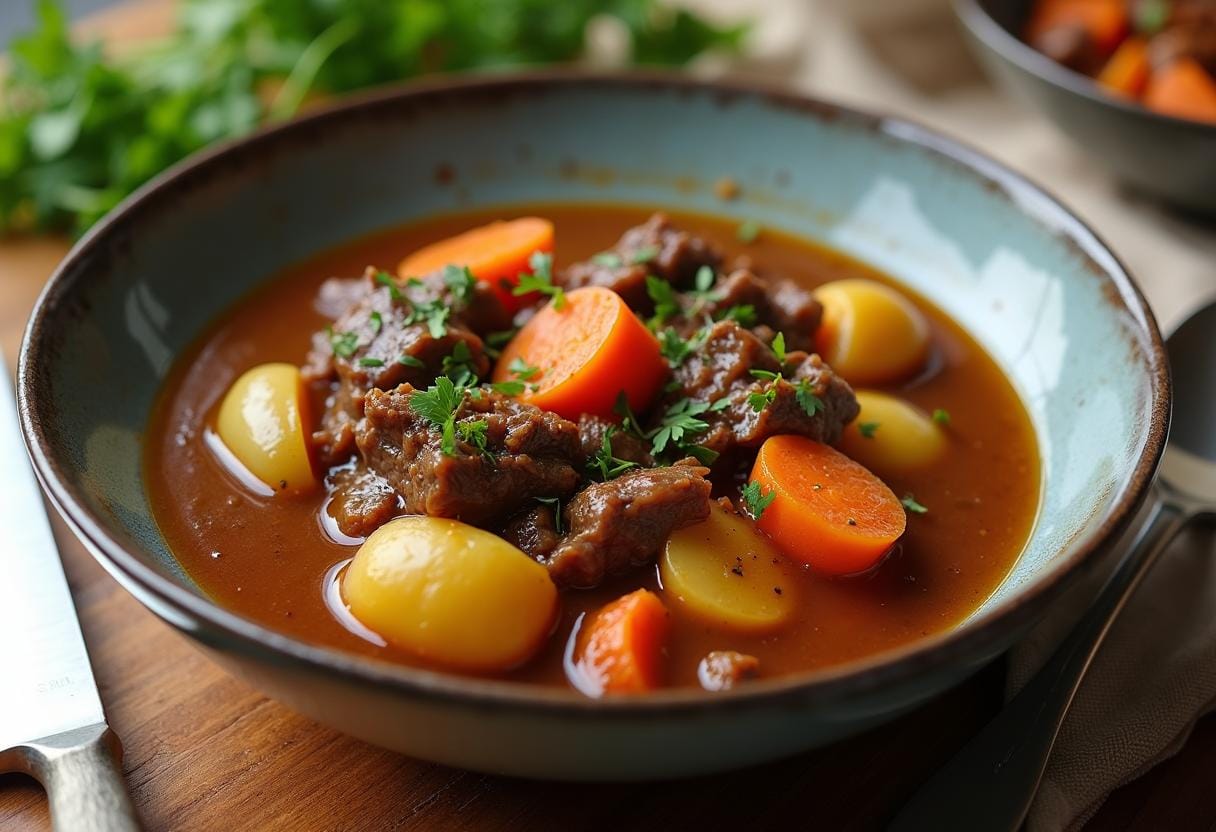Stew—just hearing the word makes you think of a warm, hearty bowl of goodness, right? Whether it’s a cold winter evening or you’re just craving something comforting and full of flavor, stew is one of the best go-to meals. But What makes a stew truly great? Understanding the Basic Stew Formula is the key to making any stew rich, flavorful, and hearty!
If you’ve ever wondered, « How do I make a stew from scratch? », then this guide is for you. By the end of this article, you’ll know exactly how to build the perfect stew—step by step! Let’s dive in.
« A great stew isn’t just food—it’s a warm hug in a bowl! »
The Core Components of the Basic Stew Formula: The 5 Essential Ingredients
At its core, a stew is a slow-cooked dish made by simmering ingredients in liquid to develop deep flavors and a rich, thick texture. The beauty of stew? It’s customizable! You can adjust the ingredients to fit different cuisines, dietary needs, or whatever is in your fridge.
Why Stew is One of the Most Versatile Dishes
Stew is:
✅ Nutritious – Packed with protein, veggies, and vitamins.
✅ Budget-Friendly – Uses affordable ingredients like root vegetables and tough meat cuts.
✅ Great for Meal Prep – Tastes even better the next day!
✅ Customizable – Works with chicken, beef, seafood, or even plant-based options.
« Stew is like a blank canvas—you can paint it with whatever flavors you love! »
The Core Components of a Stew: The 5 Essential Ingredients
Every great stew follows a Basic Stew Formula that ensures balanced flavors and textures
Protein + Aromatics + Liquid + Vegetables + Herbs & Spices
Let’s break down each element:

1. Choosing the Right Protein for the Basic Stew Formula
When selecting the best meat for a rich, flavorful stew, For the Basic Stew Formula, tough, collagen-rich cuts are essential for achieving deep flavors and tender textures If you’re unsure which meat works best, check out our guide on the best meat cuts for slow cooking.
| Protein | Why It Works | Best Cooking Time |
|---|---|---|
| Beef (Chuck, Brisket, Short Ribs) | Becomes tender and flavorful | 2-3 hours |
| Chicken (Thighs, Drumsticks) | Juicy and cooks faster | 1-1.5 hours |
| Lamb (Shanks, Shoulder) | Rich, gamey flavor | 2-3 hours |
| Plant-Based (Lentils, Chickpeas, Mushrooms) | Hearty and nutritious | 30-45 mins |
💡 Expert Tip: Tough cuts of meat are perfect for stew because they soften during slow cooking! Always go for chuck roast over sirloin—it’s more flavorful and tender.
2. Aromatics – The Secret to a Flavorful Basic Stew Formula
Aromatics are the foundation of any stew. Without them, your stew lacks depth and complexity.
Classic Aromatics (Mirepoix) – Onion, Carrot, Celery
Spicy Base (Cajun or Mexican Style) – Garlic, Peppers, Paprika
Tomato-Based Stews – Tomato Paste, Garlic, Onion
« Think of aromatics as the bassline of a song—it’s what makes everything come together! » 🎶
3. Liquid – The Role of Broths, Stocks, and in the Basic Stew Formula
The liquid choice determines the richness of your stew.
✅ Broth/Stock – Adds a deep, savory base.
✅ Coconut Milk – Adds creaminess for tropical or curry stews.
✅ Tomato Puree – Gives stews a slightly acidic, hearty texture.
4. Vegetables – How They Enhance the Basic Stew Formula
Stew isn’t stew without hearty vegetables! They add flavor, texture, and nutrition.
| Vegetable | Best For |
|---|---|
| Carrots | Sweetness and texture |
| Potatoes | Natural thickener |
| Mushrooms | Umami depth |
| Bell Peppers | Sweet and slightly smoky flavor |
« The right vegetables turn a simple stew into a masterpiece! »
5. Herbs and Spices – The Final Touch for a Perfect Basic Stew Formula
Seasoning is what makes your stew unique!
🌿 Fresh Herbs – Thyme, Rosemary, Parsley, Bay Leaves
🧂 Spices – Paprika, Cumin, Black Pepper, Cinnamon
💡 Expert Tip: Add fresh herbs at the end for maximum flavor!
« Spices are the soul of the stew—choose wisely! »
Step-by-Step Guide: How to Make a Perfect Stew Every Time
Now that you know the formula, let’s go through the cooking process step by step!
Step 1: Preparing the Ingredients – Cutting, Prepping, and Organizing
- Chop your vegetables into uniform pieces.
- Trim excess fat from your protein.
- Gather all your spices and aromatics before cooking.
💡 Tip: If you’re using beef, make sure you explore the different ways to cook beef to understand how to adjust cooking methods for the most flavor.

Step 2: Searing the Protein – Locking in Juices and Flavor
Searing the meat first adds depth and caramelization.
Heat oil in a heavy-bottomed pot.
Brown meat on all sides (about 3-5 minutes per side).
Remove and set aside before adding aromatics.
💡 Expert Tip: Don’t overcrowd the pot! Too much meat at once prevents proper browning.
« Searing is like setting the stage for a great performance! »
Step 3: Building the Base – Sautéing Aromatics for Depth
- Cook onions, garlic, and carrots until soft and fragrant.
- Stir in tomato paste for extra depth.
- Deglaze with broth to lift those flavorful brown bits from the pan!
« A good base = a great stew! »
Step 4: Adding the Liquid – The Right Ratio for Thickness
Once your protein and aromatics are ready, it’s time to add liquid. But how much? Too little, and your stew might burn; too much, and it turns into soup!
The Perfect Liquid-to-Ingredient Ratio
A good rule of thumb is:
| Stew Type | Protein (Meat, Lentils, etc.) | Liquid Amount |
|---|---|---|
| Meat-Based Stews | 500g (1 lb) | 4 cups broth/stock |
| Vegetarian Stews | 2 cups lentils/beans | 3-4 cups broth/water |
| Tomato-Based Stews | 500g meat + 1 cup tomatoes | 3-4 cups liquid |
| Creamy Stews | 500g chicken + 1/2 cup cream | 3 cups broth + 1/2 cup cream |
« A good stew is all about balance—the right liquid ratio ensures it’s rich, not watery! »
Step-by-Step Guide to Cooking the Perfect Basic Stew Formula
Here’s where the magic happens! A proper Basic Stew Formula requires slow simmering to allow flavors to develop fully
Ideal Simmering Time for Different Stews
💡 How do you know when the stew is done? The meat should be fork-tender (it easily shreds apart), and the liquid should have thickened slightly.
« A slow-simmered stew is like a great story—it takes time to develop its depth! »
Step 6: Adding Vegetables and Final Adjustments
Most vegetables cook faster than meat, so add them toward the end to avoid them turning mushy.
When to Add Vegetables to Stew?
| Vegetable | When to Add | Why? |
|---|---|---|
| Carrots & Potatoes | 45-60 minutes before done | They take longer to soften. |
| Mushrooms & Peppers | 30 minutes before done | They cook faster. |
| Spinach & Peas | 5-10 minutes before done | They wilt quickly. |
💡 Season the stew at the end! If you add salt too early, the flavors might concentrate too much as it simmers.
« Vegetables should complement the stew, not dissolve into it! »
Step 7: Thickening the Stew – How to Get the Perfect Texture
A great stew should have a rich, velvety texture—not too watery, not too thick.
Easy Ways to Thicken Your Stew
✅ Mash some potatoes or beans – A natural way to thicken without flour!
✅ Mix cornstarch with cold water – Then stir it in and simmer for 5 minutes.
✅ Use flour & butter (Roux) – Mix equal parts and stir into the stew.
✅ Let it simmer uncovered – This allows excess liquid to evaporate naturally.
« A thick, rich stew is pure comfort food! »
Common Mistakes When Making Stew (And How to Fix Them)
Following the Basic Stew Formula helps you avoid common mistakes that can affect flavor and texture.
Overcooking or Undercooking Ingredients
🚫 Problem: Meat is tough or dry.
✅ Solution: Cook low and slow until fork-tender.
🚫 Problem: Vegetables are mushy.
✅ Solution: Add hard veggies early, soft veggies later.
Adding Too Much or Too Little Liquid
🚫 Problem: Stew is watery.
✅ Solution: Simmer uncovered or add a thickener.
🚫 Problem: Stew is too dry.
✅ Solution: Add extra broth in small amounts.
« Stew mistakes happen—but fixing them is easy! »
How to Store and Reheat Stew Without Losing Flavor
Stew tastes even better the next day because the flavors develop overnight! But storing and reheating it properly is key.
H3: Best Practices for Refrigeration and Freezing
| Storage Method | How to Do It | Shelf Life |
|---|---|---|
| Refrigeration | Store in an airtight container | 3-4 days |
| Freezing | Let it cool, then freeze in portions | 2-3 months |
💡 Tip: Always let stew cool to room temperature before storing to avoid condensation.

The Right Way to Reheat Stew Without Overcooking
🚫 Mistake: Microwaving stew on high (makes meat tough).
✅ Fix: Reheat on low heat on the stovetop, adding a splash of broth.
🚫 Mistake: Reheating too many times.
✅ Fix: Only reheat the portion you need to avoid texture changes.
« A little care while reheating keeps your stew just as delicious as day one! »
Different Variations of Stews Around the World
Stew is a global dish, with different cultures adding their unique twist. If you’re interested in other beef-based stews, explore our guide on the best beef dishes from around the world.
✅ French Beef Bourguignon
✅ Moroccan Tagine – Slow-cooked with spices & dried fruits.
✅ Japanese Nikujaga – A light soy-flavored meat & potato stew.
« Stew is a dish that brings people together—no matter where you’re from! »
Conclusion: Mastering the Basic Stew Formula for Any Recipe
By now, you’ve mastered the Basic Stew Formula, ensuring every stew you make is hearty, flavorful, and satisfying
Choosing the right protein
Building a strong flavor base
Simmering low and slow for maximum taste
Avoiding common stew mistakes
So, what’s stopping you? Grab your ingredients, start cooking, and create a stew that warms your heart and belly!
What’s your favorite stew recipe? Share in the comments!

